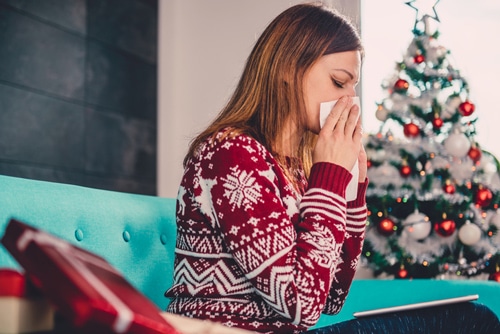Can your Christmas tree make you sick?1
Doctors have noticed for years that patients with allergies and asthma have problems around the holidays. This is true even though the typical plant allergy triggers—such as ragweed and other heavy pollen producers—are not blooming in December.
A new study examined whether Christmas trees are the culprit.
Researchers at St. Vincent’s Medical Center in Bridgeport, Conn., monitored mold spore counts in homes with real Christmas trees. They took mold readings for two weeks after a tree was brought into the homes.
They found normal mold readings in the first few days. The mold spore count was 800 spores per square meter (m2). Anything under 1,000 is considered normal.
But after day four, the count started rising. At the end of two weeks, the count had gone up to 5,000 spores/m2. That’s more than sixfold.2
Dr. Philip Hemmers is an allergist and immunologist at St. Vincent’s. He is co-author of the study. He said that mold levels caused by trees are easily high enough to cause symptoms in people who are allergic or have asthma.
“These high levels have been correlated with allergic rhinitis and an increased rate of asthma symptoms and asthma-related hospitalization in other studies,” Dr. Hemmers said.
About 13% of Americans have mold allergies. Another 8% have asthma.3 4
Although it has gotten media attention lately, so-called Christmas Tree Syndrome is not new. It was first identified in 1970. That’s when Dr. Derek M. Wyse published a paper titled “Christmas tree allergy: mold and pollen studies” in the Canadian Medical Association Journal.5
He found that about 7% of allergic people saw a spike in symptoms when they brought a real Christmas tree into their home.
Allergists note that switching to an artificial tree is not a perfect solution. They are often stored in attics or basements where they collect mold and dust, which are released when they are displayed.
And artificial trees are often made of polyvinyl chloride (PVC). “PVC releases gases known as volatile organic compounds, which are gases that can irritate the eyes, nose, and lungs,” said Dr. Glenn Harnett.6
4 Ways to Keep Christmas Allergy-Free
Here are ways to help make sure your Christmas tree doesn’t cause allergy or asthma problems:
- Keep it dry. Make sure your tree is not wet when you bring it into your home. If you see signs of moisture, keep it outside for a day or two to let it dry off.
- Keep it short. The longer you keep your tree, the higher the mold count in your home gets. Don’t keep your tree up for more than a week or two.
- Run an air purifier or dehumidifier in the room with the tree. That will keep mold levels down.
- Get a Leyland Cypress. This variety does not produce pollen or sap. Some allergic people say they don’t react to them. Leylands are generally not sold in big box stores. But Christmas tree farms in the southeast often grow them.7
One more thing… If you buy an artificial tree, look for one that is PVC-free. Those made out of polyethylene are a safer, less toxic choice.8
Like this Article? Forward this article here or Share on Facebook.
References:
1 https://www.unitedallergyservices.com/christmas-tree-syndrome/
2 http://abcnews.go.com/Health/Healthday/story?id=4509438
3 https://www.ncbi.nlm.nih.gov/pubmed/16083793/
4 http://www.aaaai.org/about-aaaai/newsroom/asthma-statistics
5 https://www.ncbi.nlm.nih.gov/pmc/articles/PMC1930673/
6 http://www.ahchealthenews.com/2015/12/18/could-your-artificial-christmas-tree-be-hazardous/
7 http://www.christmastree.org/dnn/All-About-Trees/Tree-Characteristics
8 http://www.ahchealthenews.com/2015/12/18/could-your-artificial-christmas-tree-be-hazardous/

